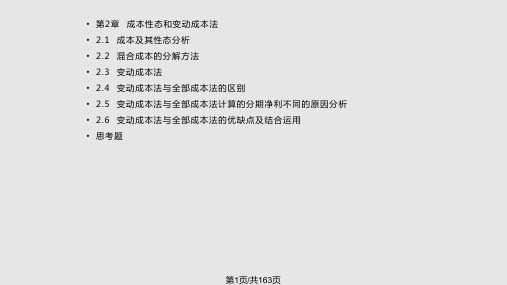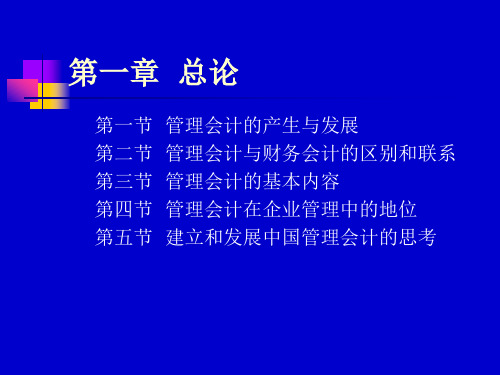管理会计学课件
管理会计全课件(全套完整课件)

保本点与保利点的计算与分析
01
保本点计算与分析
02
保本点销售量计算
03
保本点销售额计算
保本点与保利点的计算与分析
01 02 03
安全边际与保本作业率分析 保利点计算与分析 保利点销售量计算
保本点与保利点的计算与分析
保利点销售额计算
目标利润敏感性分析Βιβλιοθήκη 本量利分析在经营决策中的应用
新产品投产决策分析
成本性态分析的概念与方法
成本性态分析的概念
成本性态分析是指通过对成本与业务 量之间的依存关系进行研究,将成本 划分为固定成本、变动成本和混合成 本等不同类型的分析过程。
成本性态分析的方法
主要包括高低点法、散布图法和回归分 析法等。这些方法可以帮助企业更准确 地理解和预测成本行为,为决策提供支 持。
成本预测的方法
历史成本分析法、因素分析法、目标成本法 等。
成本预测的应用
制定成本计划、控制成本开支、评价经济效 益等。
利润预测的方法与应用
利润预测的方法
本量利分析法、敏感性分析法等。
利润预测的应用
制定利润计划、评价经营成果、进行投资决策等。
05
短期经营决策
短期经营决策的概念与特点
短期经营决策的概念
长期投资决策的风险分析
市场风险
由于市场需求变化或竞争加剧导致投资项目 收益下降的风险。
财务风险
由于资金筹措困难或融资成本上升导致投资 项目无法按计划实施的风险。
技术风险
由于技术更新或替代技术的出现导致投资项 目失败的风险。
政策风险
由于政策变化或法规调整导致投资项目受到 不利影响的风险。
THANKS
管理会计与财务会计的关系
管理会计学讲义(PPT112张)

(二)按照投资内容的不同划分
长期投资决策按其内容的不同,可分为固定资 产的投资决策和有价证券的投资。
8
二、货币时间价值
• (一)货币时间价值的概念 • (二)货币时间价值的计算
9
(一)货币时间价值的概念
货币时间价值:是指货币随着时间的推移而发 生的增值。
10
(二)货币时间价值的计算
• 1.复利终值和现值的计算 • 2.年金终值和现值的计算
47
(2)资本资产定价模型法-按照"资 本资产定价模型"公式计算
48
一般企业普通股风险溢价对其自己发行的债券 来讲,大约在3%-5%之间,当市场利率达到 历史性高点时,风险溢价通常较低,在3%左 右;当市场利率处于历史性低点时,风险溢 价通常较高,在5%左右;而通常的情况下, 采用4%的平均风险溢价。
s+1
… 递延年金示意图
n-1
n
递延年金终值FA″与递延年金现值PA″的 计算公式
FA″=A″·(FA/A,i,n-s)
P A ( P /A , i , n s ) ( P /F , i ,s ) , , A A
, ,
A [( P /A , i , n ) ( P /A , i ,s )] A A
51
计算个别资金占全部资金的比重时, 可分别选用账面价值、市场价值、 目标价值权数来计算。 任何一家企业的筹资方式都是多样化的。在筹 资决策时,仅掌握个别资本成本是不够的, 需要计算全部长期资金的成本,全部长期资 金成本是采用加权平均的方法计算出来的。 即以个别资本占全部资本的比重为权数,计 算求得的。
(二)个别资本成本
1.长期借款成本 (1)特点:借款利息计入税前成本费用,可 以起到抵税的作用;筹资费很小时可以略去 不计。
管理会计全套PPT课件

第10页/共163页
• (1)经营预测与规划 • (2)经营决策 • (3)编制预算 • 1.2.2 控制与评价会计
图1.1 管理会计基本内容及其相互关系示意图
第11页/共163页
第15页/共163页
• (5)核算程序和报表格式不同 • (6)核算方法体系不同 • (7)核算精确度要求不同 • (8)编制报表的时间不同
第16页/共163页
第2章 成本性态和变动成本法
• 学习目标 • 本章主要阐述了成本性态和变动成本法的理论问题。通过学习,了解成本分类、成
本性态分析及应用,掌握全部成本法的概念和成本流转模式,变动成本法的概念和 成本流转模式,全部成本法与变动成本法之间的区别,按全部成本法和变动成本法 计算的税前净利之间的相互转换以及这两种成本计算法的结合运用。
复式记账法原理为标志,以货币为主要计量单位,以复式的经济活动或预算账为 基本手段,对企业、机关、事业单位或其他经济组织乃至个体经营者的经济活动 或预算执行过程及其结果连续地、系统地进行核算,并根据核算资料进行分析和检 查的一种管理经济的工具。
第 • 1.1.3 管理会计的发展 • 1.2 管理会计的基本内容 • 1.2.1 规划与决策会计 • 规划与决策会计是利用会计、统计资料和其他业务数据,运用各种数学方法,对
• 首先,以合计数( )的形式,表达y=a+bx中每一项,得 • 再以业务量x乘y=a+bx中的每一项,然后相加得
第25页/共163页
• 然后将(2.1)式移项化简后,得
• 将(2.3)式代入(2.2)式,并化简得
教学课件管理会计学

三、成本按其抵消收入的时间分 类
成本按其抵消收入的时间分为产品成本 和期间成本
产品成本
产品成本是指与生产过程相联系并且由 某种产品负担的成本。
期间成本
期间成本是指按会计期间发生的,并随 着时间的消逝而逐渐丧失的成本。期间 成本与产品生产没有直接联系,它是在 时间消逝的基础上与期间收入相联系, 抵消当期收入。
第一章 总论
第一节 管理会计的产生与发展 第二节 管理会计与财务会计的区别和联系 第三节 管理会计的基本内容 第四节 管理会计在企业管理中的地位 第五节 建立和发展中国管理会计的思考
第一节 管理会计的产生与发 展
从英国产业革命开始,资本主义经济有 了较快的发展,原有的单凭经验管理企 业的方法,已不能适应经济的迅速发展。
固定成本(Fixed Cost)
固定成本是指其总额在一定时期和一定 业务量范围内,不受业务量增减变动的 影响而相对保持不变的成本。
包括生产成本中的固定资产折旧费、保 险费、财产税、工厂照明费等固定制造 费用,这些可归类为固定生产成本。
非生产成本中的大多数项目都是固定的, 如广告费、管理与行政人员工资、办公 费等,这些可归类为固定非生产成本。
一、混合成本的种类
混合成本一般可分为三类:半变动成本、 阶梯式成本和延期变动成本。
(一)半变动成本
此类成本由固定与变动两部分组成,它 通常有一个初始量,作为基数保持不变, 类似于固定成本;在这个基数以上,成 本则随业务的增加而成正比例增加,这 部分类似于变动成本。
(二)阶梯式成本
此类成本在一定业务量范围内其发生额 是固定的;当业务量增长超过这个范围, 其发生额会突然跳跃上升;然后在业务 量增长后的一定范围内,其发生额又保 持不变,直到下次跳跃为止。
《管理会计》PPT课件

•管理会计概述•成本性态分析与变动成本法•本量利分析•经营预测与决策目录•全面预算管理•责任会计与业绩评价管理会计的定义与特点定义管理会计是会计学的一个分支,主要为企业内部管理服务,通过一系列专门方法,利用财务会计提供的资料及其他资料进行加工、整理和报告,使企业各级管理人员能据以对日常发生的各项经济活动进行规划与控制,并帮助决策者作出各种专门决策的一个会计分支。
特点侧重于为企业内部管理服务、方式方法灵活多样、兼顾全局和局部两个方面、面向未来、会计信息不受会计准则约束。
管理会计与财务会计的关系联系区别管理会计的职能与作用职能作用成本性态分析的概念与方法成本性态分析的概念成本性态分析的方法高低点法、散布图法、最小二乘法等。
变动成本法的特点与优势变动成本法的特点变动成本法的优势变动成本法与完全成本法的比较产品成本构成内容不同存货估价及成本流程不同分期损益不同相关范围假设模型线性假设01 02 03边际贡献率= 边际贡献/ 单价变动成本率= 单位变动成本/ 单价保本点业务量保本点销售额1 2 3010203确定联合单位(多种产品的固定比例组合)计算联合单位的边际贡献和保本点销售额联合单位法多产品的本量利分析定性预测法定量预测法确定预测目标明确预测的对象、期限和范围。
要点一要点二收集和分析资料收集相关历史数据、市场信息和专家意见,进行整理和分析。
根据预测目标和资料特点,选择合适的预测方法。
选择预测方法运用选定的预测方法进行计算和分析,得出预测结果。
进行预测对预测结果进行检验和评估,判断其准确性和可靠性。
评估预测结果战略决策涉及企业长期发展方向和目标的决策,如市场定位、产品策略等。
管理决策为实现战略目标而进行的日常管理决策,如生产计划、销售策略等。
明确决策要解决的问题和达到的目标。
收集信息收集与决策相关的各种信息,包括内部信息和外部信息。
确定决策目标VS提出备选方案对备选方案进行评估和比较,分析其优缺点和风险。
管理会计学(全套298P) ppt课件

三、变动成本法理论依据
1、产品成本是随着产量增减而增减的变动成本。 2、固定性制造费用只能作为期间成本,从当期的销售 收入中一次性扣除。
60
第二节 变动成本法与完全成本法的区别
1、完全成本法(全部成本法) 是一种将直接材料、直接人工和全部的制造费用作
为产品成本的计算方法。 2、变动成本法
是一种将直接材料,直接人工和变动性制造费用作 为产品成本,将固定性制造费用作为期间成本计算方法。
2、变动成本法:有其严格的应用前提,必须把全部成 本分为固定成本和变动成本。
63
三、 产品成本、期间成本的构成内容不同
(一)产品成本的构成内容不同 主要区别在于如何处理固定性制造费用。
(二)期间成本的构成内容不同 完全成本法将非生产成本——推销成本和管理成本,
y
y=a0+b0(x-x0)
y=a0
x0
x
41
2、混合成本的分类
(4)曲线式混合成本 曲线式混合成本有两种类别: 递减型混合成本、递增型混合成本
42
①递减型混合成本模型
y
x
43
②递增型混合成本模型
y
x
44
第三节 混合成本的分解方法
混合成本的分解方法主要有三种: 合同确认法、技术测定法和数学分析法。
61
一、理论依据不同
变动成本法:固定制造费用主要是企业提供一定的生产经 营条件而发生的,这些生产经营条件一旦形成,不管其实 际利用程度如何,有关费用照样发生,他们与产品的实际 产量没有直接联系。 完全成本法:只要与产品的生产有关的成本都应该作为产 品成本
62
二、应用的前提条件与成本构成内容不同
1、完全成本法:不需要划分固定成本和变动成本之间 的界限。
管理会计学第1章PPT课件

05
其他非财务指标
04
对现有产品进行成本管理
①作业成本法
03
②生产过程控制
③完善成本计划
02
确定现有产品与未来产品的产品组合
①明确成本管理在竞争中的关键程度
01
②产品技术的成熟性
③产品生命周期
战略成本管理的内容
可编辑课件PPT
19
1.3
管理会计的基本理论
可编辑课件PPT
20
1.3.1 管理会计的对象
可编辑课件PPT
15
外部环境 分析
战略制定
内部环境 分析
战略实施
战略评价和控制
战略管理流程
可编辑课件PPT
16
A
纵向价值链
①产业进入和产业退出的决策 ②纵向整合的决策
B
横向价值链
①确定与竞争对手的差异 ②确定取得相对竞争优势的战略
C 内部价值链 ①基本职能活动 ②人力资源管理活动 ③生产经营活动
可编辑课件PPT
11
搬运生铁块试验 与铁锹试验
搬运生铁块
可编辑课件PPT
12
此外泰勒还对每一套动作的精确时间作了研究,从而得出了一个 “一流工人”每天应该完成的工作量。
这一研究的结果是非常杰出的,堆料场的劳动力从400-600人减 少为140人,平均每人每天的操作量从16吨提高到59吨,每个工人的日 工资从1.15美元提高到1.88美元。
1 实质
是企业的生产经营活动
2 管理体现经济效益
是企业生产经营活动中的价值活动
3 实践角度
管理会计的对象具有复合性的特点。 一方面强调加强作业管理;另一方 面强调加强价值管理。
可编辑课件PPT
《管理会计》ppt课件

变动成本法下,首先计算 贡献毛益,再计算营业利 润;完全成本法下,首先 计算营业毛利,再计算营 业利润。
03
本量利分析
本量利分析的基本原理
成本性态分析
将成本划分为固定成本和 变动成本,揭示成本随业 务量变动的规律。
盈亏平衡点分析
确定企业在一定业务量水 平下实现盈亏平衡的条件 。
目标利润分析
预测企业在特定业务量水 平下实现目标利润的可能 性。
《管理会计》ppt课件
• 管理会计概述 • 成本性态与变动成本法 • 本量利分析 • 经营预测与决策 • 全面预算管理 • 责任会计与业绩评价
01
管理会计概述
管理会计的定义与特点
定义
管理会计是会计学的一个分支,主要服务于企业内部管理,通过提供财务信息 和非财务信息,协助企业做出决策、规划和控制经营活动。
03
责任会计的基本要素
责任会计的基本要素包括责任中心、责任预算、责任报告和责任考核,
这些要素共同构成了责任会计的完整体系。
责任中心的划分与考核
责任中心的定义
责任中心是企业内部具有一定经济责任和权限的部门或单位,是责 任会计的实施主体。
责任中心的类型
根据经济责任和权限的不同,责任中心可分为成本中心、利润中心 和投资中心三种类型。
按照事先设定的产品优先级顺序,逐步计算 各产品的贡献毛益和保本点,以此为基础进 行多产品的本量利分析。
04
经营预测与决策
经营预测的方法与技巧
时间序列分析法
利用历史数据,通过时间序列 模型进行趋势分析和预测。
因果分析法
分析影响经营活动的各种因素 ,建立因果关系模型进行预测 。
专家意见法
利用专家经验和知识,通过德 尔菲法、头脑风暴法等方法进 行预测。
- 1、下载文档前请自行甄别文档内容的完整性,平台不提供额外的编辑、内容补充、找答案等附加服务。
- 2、"仅部分预览"的文档,不可在线预览部分如存在完整性等问题,可反馈申请退款(可完整预览的文档不适用该条件!)。
- 3、如文档侵犯您的权益,请联系客服反馈,我们会尽快为您处理(人工客服工作时间:9:00-18:30)。
Appliance Division $117,000,000 3,510,000 19,500,000 $117,000,000 2,925,000 19,500,000
$40,000,000 2,000,000 10,000,000
Margin and Turnover Comparisons
Snack Food Year 1 Margin Turnover ROI 6.0% x 3.0 18.0% === Year 2 5.0% x 4.0 20.0% ===
Appliance Year 1 3.0% x 6.0 18.0% === Year 2 2.5% x 6.0 15.0% ===
PPT 10-7
Components of ROI
Decomposition of the ROI formula: ROI = Operating income/Average operating assets = (Operating income/Sales) x (Sales/Average operating assets) = Operating income margin x Operating asset turnover
PPT 10-8
10-9
Understanding ROI
Net operating income ROI = Average operating assets Net operating income Margin = Sales Sales Turnover = Average operating assets ROI = Margin × Turnover
ROI = Margin × Turnover
ROI =
Net operating income Sales
×
Sales PPT 10-13 Average operating assets
10-14
Increasing ROI – An Example
ROI = Margin × Turnover
(
Average operating assets
×
Minimum required rate of return
)
ROI measures net operating income earned relative to the investment in average operating assets. Residual income measures net operating income earned less the minimum required return on average operating assets.
PPT 10-6
10-7
Net Book Value versus Gross Cost
Most companies use the net book value of depreciable assets to calculate average operating assets.
Acquisition cost Less: Accumulated depreciation Net book value
Suppose that Regal's manager invests in a $30,000 piece of equipment that increases sales by $35,000, while increasing operating expenses by $15,000.
Regal Company reports the following:
PPT 10-23
Residual Income Example
Project I Investment Operating income Targeted ROI $10,000,000 1,300,000 10% Project II $4,000,000 640,000 10%
assets.
PPT 10-17
Disadvantages of the ROI Measure
G It discourages managers from investing in
projects that would decrease the divisional ROI but would increase the profitability of the company as a whole. (Generally, projects with an ROI less than a division’s current ROI would be rejected.)
PPT 10-9
An ROI Example
Year 1: Snack Foods Division Sales $30,000,000 Operating income 1,800,000 Average operating assets 10,000,000 Year 2: Sales Operating income Average operating assets Minimum return of 10%
G It can encourage myopic behavior, in that
managers may focus on the short run at the expense of the long run.
PPT 10-18
10-19
Criticisms of ROI
In the absence of the balanced scorecard, management may not know how to increase ROI. Managers often inherit many committed costs over which they have no control. Managers evaluated on ROI may reject profitable investment opportunities.
PPT 10-11
10-12
Increasing ROI
There are three ways to increase ROI . . .
Reduce Increase Expenses Sales Reduce Assets
PPT 10-12
10-13
Increasing ROI – An Example
Return on Investment (ROI) Formula
Income before interest and taxes (EBIT)
Net operating income ROI = Average operating assets
Cash, accounts receivable, inventory, plant and equipment, and other productive assets.
$535,000 × $230,000
ROI = 9.35% × 2.33 = 21.8% ROI increased from 15% to 21.8%.
PPT 10-16
Advantages of ROI
G It encourages managers to pay careful attention
G Residual income = Operating income -
(Minimum rate of return x Operating assets)
PPT 10-22
10-23
Calculating Residual Income
Residual = income Net operating income
Net operating income above some minimum required return on operating assets
PPT 10-21
Residual Income
Residual income is the difference between operating income and the minimum dollar return required on a company’s operating assets:
PPT 10-4
10-5
Return On Investment (ROI)
Compute return on investment (ROI) and show how changes in sales, expenses, and assets affect ROI.
PPT 10-5
10-6
to the relationships among sales, expenses, and investment, as should be the case for a manager of an investment center.
G It encourages cost efficiency. G It discourages excessive investment in operating
ADVANCED MANAGEMENT ACCOUNTING
PPT 10-1
Performance Evaluation
PPT 10-2
Learning Objectives
G Compute and explain return on investment
(ROI), residual income (RI), and economic value added (EVA)
Net operating income Average operating assets Sales Operating expenses $ 50,000 $ 230,000 $ 535,000 $ 485,000
